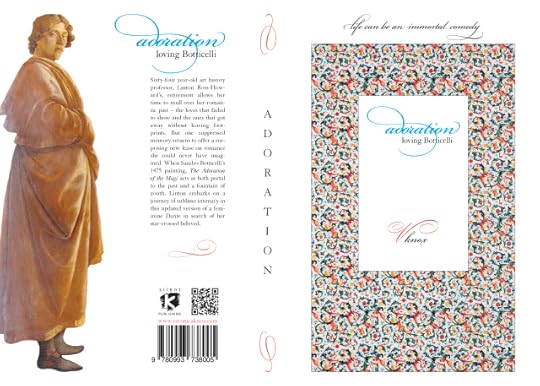Veronica Knox's Blog, page 18
July 16, 2014
Cherry White

I spy with my little eye
something beginning with fire
Erased emotions quicken when ethics challenges the cold logic of a sentient computer, programmed to save lost art first, regardless of the consequences to those who created it.
genre: science-fiction
‘CHERRY WHITE’ synopsis:
Cherry White considered her second life as a time traveler to be a curse until she encountered an untapped source of overwhelming love.
Once a human autistic savant, Cherry is now labelled an ‘it’ by her cybernetic creators, but her damaged senses regenerate when ethics challenge the cold logic of her new role as a sentient computer programmed to save art first, regardless of the consequences to those who created it.
Her function as an organic android is to sift time, scan for destroyed masterpieces, and harvest them for the Fire Gallery of the Phoenix Project.
Lost art consumed by fire is an asset the project’s syndicate of investors deem worthy of breaching the time continuum and human dignity to obtain, but Cherry’s rekindled memories demand a sacrifice when she’s faced with choices that threaten to eclipse her newfound love and destroy a priceless painting by Leonardo da Vinci.
When a surprising anthropology lesson reveals the mysteries of her distant past and explains her erratic life as a mystic savant, Cherry is inspired to mutiny.
Her new allies, the unexpected restoration of primal instincts, and an astonishing quickening of dormant genes create an opportunity to make historic reparation at the expense of extinguishing an amazing scientific breakthrough.
A bizarre plan of sabotage promises to rejuvenate the evolution of compassion in order to revive the highest order of humankind.
Lost art, lost love, a lost species, and a gathering of lost souls are at risk of annihilation, unless Cherry’s conflicting emotions and her allegiance to art can be resolved…‘in time.’
“Joanne was relieved. She had been afraid the job was going to be clinical. The manicure had fooled her. Cherry was groomed to perfection like a doll, but she had emotional dirt under her nails. Genius dirt. The profound dirt of survival in a lonely world that continued to exploit her. The woman had Mona Lisa eyes.”
page 88
state of the art meets an extraordinary state of mind
‘Cherry White,’ is a work in progress, due to be published in November, 2014
an extraordinary woman has to experience being an android before she understands what it means to be human


July 13, 2014
Erotic Million Dollar Leonardo Destroyed by an Hysterical Woman?
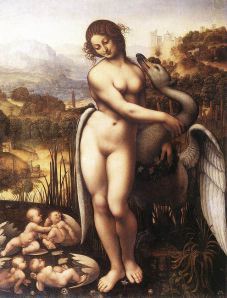
‘Leda and the Swan’ – a copy from the lost original by Leonardo da Vinci
One 17th century woman may have decided this painting was an image too far. The original version of ‘Leda and the Swan’ by Leonardo da Vinci was last seen in 1625 and believed to be destroyed on the grounds of its adverse effects on the frazzled nerves of the wife of a diplomat, into whose hands it, unfortunately, came to rest. Fortunately, it was copied, and we can see Leonardo’s composition.
The ‘Leda and the Swan’ theme of the mythical abduction of Leda by Zeus after taking the form of a swan, was in great vogue during the fifteenth-century. However, subsequent times and super-sensitive moralities rendered the images lewd and too erotic to survive. See the copy of Michelangelo’s version, also considered destroyed.
Pass the smelling salts.
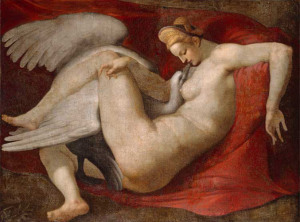
‘Leda and the Swan’ copied from Michelangelo’s lost original by Peter Paul Reubens
So, in times for scapegoat (or scape-swan) sensitivities, a few self-appointed gatekeepers burned, erased, planted bumper crops of fig leaves for decorum’s sake, and painstakingly ‘corrected’ many priceless sketches and paintings.
But, Leonardo’s ‘Leda’ may yet be found. It may have been secreted away, or disfigured by an over-painting. At this moment, it may be lingering anonymously on an office wall or stored in an attic. Perhaps it’s still secreted away in a forgotten World War II cache of confiscated art.
I explore the whereabouts of Leonardo’s ‘Leda’ in my novel-in-progress ‘Cherry White,’ to be published in November, 2014. My next post will give the details.
Another, anatomically-correct drawing of a male nude from Leonardo’s studio suffered the humiliation of being partially erased to appease its squeamish owner. The offensive realities of the flesh had been too much. The drawing is still worth hundreds of thousands of dollars, but imagine the audacity (read stupidity) to alter a work known to be a ‘Leonardo.’ It was bad enough that a few light-fingered enthusiasts cut segments from Leonardo da Vinci’s precious folios for their own collections, let alone disfigured or burned them under the guise of moral decency.
For many years, a generation of the British Royal Family overlooked the very trunk-load of Leonardo’s manuscripts which eventually became the heart of their famous Royal Collection. The treasure chest lingered in obscurity out of sight and mind, misidentified as insignificant. Who knows what works have not been publicly aired.
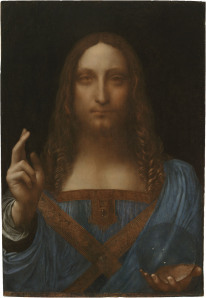
The recently unearthed ‘Salvator Mundi’ attributed to Leonardo da Vinci.
The latest of two ‘Leonardos’ to emerge in our century, the ‘Salvator Mundi’ (the saviour of the world) was once sold at auction in 1958 for forty-five pounds sterling (roughly $90) and lingered in obscurity for fifty years more. It recently sold for $85,000,000 (a bargain considering it has been valued at three times that amount)
Sadly, the recent ‘buyers syndicate’ or singularly wealthy owner is not public knowledge, so the painting has disappeared again, into a personal location or storage vault when it should have become ‘Qualitus Mundi’ (the property of the world), on display for all to enjoy. Hopefully there will come a day when such masterpieces cannot be privately secreted away, where they’re likely to be copied, moved about surreptitiously, or otherwise compromised to join the underground ranks of the sad category ‘now lost’ which should be more correctly listed as ‘now lost… again.’
Can important art be privately owned? The answer of course, is yes. Especially in the past when travelers could pick up a master painting for a few desperate shillings, acquiring the unsung for a song.
The people fortunate enough, who unknowingly harbor such ‘dormant’ works, should be compensated for their discoveries by public galleries, but surely these masterpieces must become the property of art history.
What work of art would you most like to own? Presuming (tongue-in-cheek) it could be purchased for a little more than a self-published novel, or at least under a hundred dollars.
My choice would be Vermeer’s ‘Girl with a Pearl Earring’… and if I were lucky enough to find myself the temporary owner of such a work, I would sell it on to a major gallery so everyone would be the richer.
Do you believe great art is the property of the world?


July 12, 2014
Twinter

‘HOURGLASS of TIME’ – a painting by Veronica Knox
TWINTER = a story of winter, twins, science, and magic
‘Twinter- the first portal’ is a novel-length fantasy for middle-grade readers, age ten to eleven. Recommended for advanced readers.
Twelve-year-old twins, Kit (a keen scientist) and Bash (a girl with a miraculous green thumb and a flair for elaborate words) are excited to be moving from a noisy city to Bede Hall, their eccentric grandmother’s crumbling stately home, set in the sleepy English countryside.
With all that’s gone horribly wrong for a year, it’s about time life got back on a positive track. Moving to a grand old mansion seems the answer that promises an adventure of endless exploration and freedom. Bash can create the garden of her dreams and Kit has an abandoned space to set up his own laboratory.
Instead, they begin to uncover the supernatural secrets of a mysterious village, meet the ghost of Bede Hall and some unexpected life-forms, some of whom, are just as haunted as the presence of the hapless young girl trapped in the attic.

It’s all ‘about time’ when the twins discover a portal to the future. Can they also travel to the past and unravel the truths of natural history in order to save the planet from a natural disaster? The answers lie in Ancient Egypt, but only time will surrender its hidden knowledge.
The responsibility of holding the future of the world in the twin’s hands is as bizarre as their grandmother’s magic snow globe.

‘Twinter- the first portal’

read an excerpt here


July 10, 2014
Birds and Bees

‘Bee Angelus’ – by Veronica Knox, 2013
Genetics aside, hybrid creatures can inspire the multifaceted characters who inhabit paranormal fiction.
Paranormal does not need to infer Gothic horror, but rather the magic of the imagination: time travel, fanciful species, dreams of living five-hundred years ago, indeed living a previous existence as a bee or a great artist.
Children’s stories sometimes have to be told from a bee’s point of view: the fly on the wall or the bee on the flower, as did a TV animation featuring a girl bee named Maya who was a bit of a princess. Did she grow into the queen of her hive? If not, is there a new fairy tale about a restless girl titled ‘The Princess and the Bee’? The animation It’s a Bug’s Life transported us into a world which is true to scale and otherwise aligned to a metaphor that (for me) encapsulates the publishing industry. There are a million stories (read books) in the big anthill. Industrious barely describes the degree of activity involved in creating a book with a life of its own.
In reality, the insect world has far different challenges than ours, but however thinly sliced, the birds and the bees and the ants and the peacocks offer windows into the human spirit.
The peacock is a symbol of rebirth. The bee is known for its relentless dedication to the greater hive. Humans are referred to as ants on a giant spinning sphere. Then there’s the definition of animation (to have life) … Maya means illusion. These themes have to be squeezed into a ‘genre’ in order to be found.
I painted this bee bee-cause my daughter wanted a painting of a peacock. She also collects all thing ‘bee,’ and she asked for something different. What to paint? What to create for her? It was Christmas, so I was feeling kind of angelic.
In writing a novel, this different-but-the-same issue, arises.
Genres are categories meant to guide readers. Like a treasure map (the internet), one wants to avoid booby-traps (spin and spam), circumvent poetic clues (the overworked synopsis), and find the pot of gold (bestseller) at point X. But…
When is historical merely hysterical? When does a love story become a romance novel? What does one call an historical fantasy time-slip paranormal mystery adventure ghostly love story? When is a metaphor more than a literary device? How does an obscure author fly? How does a new novel create buzz?
… When is a bird a bee?


July 7, 2014
Loving Botticelli
I love the concept of a painting interacting with a viewer. ‘The Portrait of Dorian Gray’ by Oscar Wilde aged while the man remained young. I have always wanted to step into a narrative painting and look around behind the scene and learn what hypothetical conversations the artist intended his figures to be having. What had just been said? What were they thinking? Why were they there?
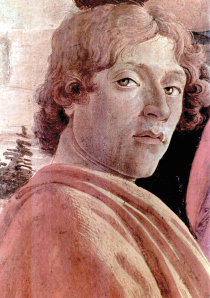
Sandro Botticelli
Artists of the fifteenth century invented an ingenious way of letting the public (at the time) know who painted the work by painting their self-portraits in the right hand lower corner of their painting. From this position, they invited mortal spectators to join the painted figures and enter the picture plane to view the holy event of the Jesus’s birth. In the case of Leonardo’s unfinished ‘Adoration of the Magi’ (see my blog for June 23) he also gestured with his arm, indicating the way to follow.
Adorations were a popular theme. Rich patrons wanting to glorify their existence were painted in the crowd. In the 1475 Adoration by Sandro Botticelli, the artist stands aloof with his arms folded, and his eyes seem to dare one to enter, or do they say more? In my novel, ‘Adoration – loving Botticelli,’ they entice a ghostly lover from the twenty-first century.
There are other places to see the famous artists of the day. Raphael incorporated several likenesses of contemporary artists and dignitaries into his ‘School of Athens.’ This large panel is one of my personal favourites. Leonardo and Michelangelo are there as the young Raphael would have seen them or known other representations of them. In addition Raphael painted his self-portrait in roughly the same region as the convention of the day, in the lower right hand area of the painting. We can confirm it is the artist as he is in the position reserved for that of the artist/host and is making eye contact with the viewer to bridge the picture plane to the third dimension.
So, the dryness of art history can sometimes offer us a juicy photo gallery. Leonardo was also ‘captured’ in stone at the age of thirteen when he posed for Andrea Verrocchio’s statue of David.
In my next blog we will see Leonardo at thirteen, twenty-four, thirty-five, and as an elderly magus in his sixties. Perhaps he even posed as an infant for one of Verrocchio’s Madonna and child icons or even an angel. Think of all the holy infants in icons who were once plain offspring bounced on their mother’s knees for artists to capture and glorify, and the anonymous maidens culled from daily life to sit in robes of blue to represent the Virgin Mary.
The master, Verrocchio was both neighbour and friend to Leonardo’s lawyer father, Piero da Vinci. He was also a client. Large studios worked to contracts that outlined details of payment as well as time deadlines and the specific elements expected within a composition. Often these would be portraits of the benefactors and those in power they wanted to impress. In addition, it was expressly …. That the most senior master would paint the faces of the holy figures, which also accounts for so many poorly rendered infants. Verrocchio was first and foremost, an architect and sculptor. His painted figures are solid. Their draperies hang as heavy as stone, and their anatomy is static. The rest of a studio compilation was shared in reducing levels of competency from the highest assistants to the youngest apprentices.
‘ADORATION – loving Botticelli’ synopsis
Sixty-four year-old art history professor, Linton Ross-Howard’s, retirement allows her time to mull over her romantic past – the loves that failed to show and the ones that got away without leaving footprints. But one suppressed memory returns to offer a surprising new lease on romance she could never have imagined. When Sandro Botticelli’s 1475 painting, The Adoration of the Magi acts as both portal to the past and a fountain of youth, Linton embarks on a journey of sublime intimacy in this updated version of a feminine Dante in search of her star-crossed beloved.
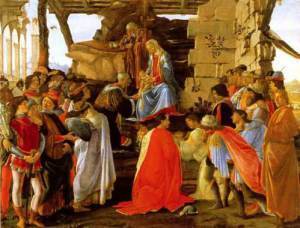
‘Adoration of the Magi’ – Sandro Botticelli, 1475
Read excerpt here


July 3, 2014
A Sign of the Times?
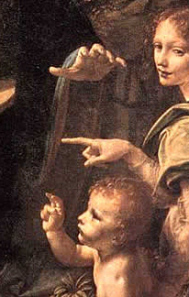
Details from the ‘Madonna of the Rocks’ in the Louvre. Are these hand gestures sign language? Did Leonardo sign his initials: LDV?
Artists were not permitted to sign their paintings in the fifteenth century. Even the subjects’ identities were disguised under a layer of flattering (or covertly unflattering) iconography. Anagrams, puns, links to family crests, and professed virtues linger under ambiguous titles provided much later. The titles of paintings were more general descriptions considering documentation and eye witnesses were long gone by the time subsequent generations named them.
Woman with a ferret? Musician Playing a Lute? But what woman? What musician? Why a ferret? Why point a finger at something unimportant? More importantly, why play by the rules?
It’s fair to assume Leonardo made his own rules in his rise to discovering the secrets of anatomy, and religious affiliations were easier to cover up because popular holy stories and themes eclipsed any personal iconography of the artist’s. It helped that Leonardo was a master of the art of subtlety. He’d been keeping his thoughts to himself for years. After all, declaring a man could fly was tantamount to blasphemy. Hiding models of flying machines was perhaps the hardest of all, but nevertheless, it is documented Leonardo tested his ornithopters from Mt. Cerceri, a nearby mountainside.

1

2
In my novel, Second Lisa, I premise Leonardo uses sign language in the version marked number 1 (see left) of the ‘Madonna of the Rocks,’ to declare his connection under the noses of the authorities.
There is some pentimento evidence to presuppose this.
A pentimento, derived from the Italian word pentirsi, meaning repentance, is an under-drawing which indicates where an artist has altered their original design. Sometimes these ghostly images appear in plain sight as a painting fades, but more often, they only become visible through the use of infrared cameras. State of the art forensic cameras using X-ray and reflectographic technology can also reveal completely different images under the visible work, but in the case of the ‘Madonna of the Rocks’ fig. 2, they show a previous composition. A variation from the (considered) original cartoon shows the figure of Mary no longer holding her hand over an infant’s head.
The two versions were painted years apart due to a binding contract to deliver the painting to the Confraternity of the Immaculate Conception after it was refused due to the complaint it failed to adhere to the original specifications.
After prolonged refusal to pay, the artists in partnership sold the painting to another patron. The second version fulfilled the legal obligation but it was missing one of the original elements. Why did Leonardo remove the angels pointing hand gesture?
The ‘Madonna of the Rocks’ was painted as a collaborative commission in the art studio of the de Predis brothers, in Milan. One of the brothers who worked alongside Leonardo, was deaf and likely taught Leonardo the art of signing. What better way to sign a work covertly than in the open. Wouldn’t that be the perfect finishing touch of the artist we’ve come to celebrate as the iconic Renaissance Man?
Hats off to Leonardo. Boo to the authorities who tried to control art and intimidated artists from acknowledging their own works (including the invisible workforce of women painters who worked, uncredited, alongside their male counterparts)
It’s rather obvious that the artist has taken pains to show the hand gestures in a vertical line. Hardly an accident of composition if one wanted them to be ‘read’ together.
So, I ask you. Could these hand gestures be sign language? Do they spell out the initials LDV? The Madonna’s left hand forms an L, the pointing gesture was once known to represent the letter D, and the infant’s sign of benediction forms the letter V. All ‘signs point’ to a yes, for me.
My next blog will feature excerpts from my latest paranormal time-slip novel to the quattrocento of the Italian Renaissance, ‘Adoration – loving Botticelli.’ This love story (accepted genre: paranormal romance) pairs Sandro Botticelli with a woman from the twenty-first century. Think, Oscar Wilde’s ‘Portrait of Dorian Gray,’ and the wonderful book, ‘Time Traveler’s Wife,’ and you will be halfway there.


July 2, 2014
Seeing Double
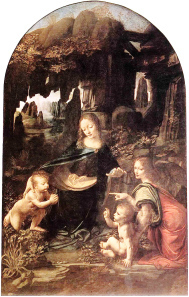
‘Madonna of the Rocks’ by Leonardo da Vinci. The Louvre version.
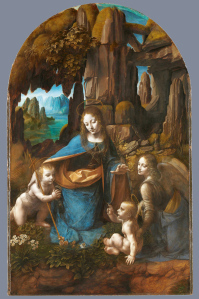
‘Madonna of the Rocks’ the National Gallery version.
Leonardo painted two ‘Madonna of the Rocks,’ so why not two Mona Lisas?
Provenance is sketchy, but amongst the many copies of the ‘Mona Lisa’ by Leonardo’s students and admirers, one stands out as a
possible second ‘Lisa.’ Spectro cameras reveal that changes in the background were made simultaneously to both portraits, which strongly suggests they were painted side-by-side.
Regarding the double ‘Madonna of the Rocks’ paintings, there were extenuating legal circumstances which obliged Leonardo to fulfill the original contract by painting a duplicate. My biography of Leonardo’s sister, Lisabetta Buti, ‘Second Lisa’ reveals why.
Sketchy historical fragments pieced together are mostly guesswork as the works were begun when Leonardo was thirty-one years old and were still in debate twenty-five years later.
Iconography, the pictorial devices engaged to ‘narrate’ the story of a painting, always speaks silent ‘volumes’ when Leonardo is involved. He was the master of secret writing, philosophy, anatomy, music, botany, engineering, and alchemy, as well as painting and sculpture.
Most religious figures are known by their allegorical attributes. The two babies pose the perfect disguise for understating the personal religious affiliations of the artist. The infants are naked and therefore, anonymous. So, which one is the Christ-child and which is John the Baptist? Tradition says the baby placed highest in the picture plane should be Jesus. Until the alternative version of the composition, the babies were assumed to be: Jesus on the left (in the higher position as dictated by the hierarchy of his status) but Leonardo was believed to be a clandestine follower of John (the patron saint of Florence) so could he have painted John as the dominant figure? A baby is a baby. Which infant was John?
It would have been sacrilegious to portray the infant Jesus lower in the picture plane, however after twenty-five years of haggling over non-payment, the version (considered second) adds two vital clues. John is now identified with his staff and Jesus has been given a halo. But now the angel is acting coy and averts his eyes. No longer does he point to one of the babies. John is in the ‘highest’ position, and therefore has been subtly awarded precedence over Jesus. Leonardo is making a point. When did he not?
If the second painting was rendered under his supervision rather than entirely by his own hand, he would not have signed it. Was he thumbing his nose at confraternity of brothers who commissioned the work? Hmmnnn?
I always afford Leonardo the benefit of the doubt. He was a man of secrets. His writing in codes presumes he considered his privacy to be under scrutiny. Never one to back down, isn’t it more likely he was outspoken by ‘hiding’ his thoughts out in the open for all to see? I premise there will always be secret messages in the master’s paintings as was his right to be heard during a time when it was dangerous to argue with the church authorities or its representatives.
In my fantasy novel ‘Second Lisa,’ I premise more detailed answers: the original painting was executed entirely by the hand of the master and was ‘signed’ whereas the second painting was painted by another with his occasional assistance. The original cartoon was used for both, but the ‘stories’ within each version were subtly changed.
Leonardo had every means at his disposal to paint his personal preferences into his compositions, partly to satisfy his ego, partly for his rebellious nature, let alone (in the instance of the controversial dispute of the ‘Madonna of the Rocks’) to express his continuing annoyance over being shortchanged.
It is best to also recall, despite Leonardo’s ongoing estrangement with his birth father, he was born into an ongoing generation of da Vinci lawyers. The family law firm would have left its mark on the impressionable boy who lived with the da Vinci clan from the age of six until he left home as a pre-teen apprentice (age twelve), and their influence continued to impact his life.
By the time the final ‘Madonna of the Rocks’ was installed in 1508, Leonardo was fifty-six years old and, as usual, in need of funds. It seems Leonardo was frequently in dire financial straits. Painting no longer ruled his interests at this time; it may have even been an annoying distraction, since Leonardo was more philosopher and engineer than painter. 1508 was before eventual financial relief came in the guise of a ‘rescue’ when he was whisked away from Italy and the hassles that continually lingered over his unfinished and abandoned works. He lived eleven more years clinging to the ‘Mona Lisa.’ Why?
Within eight years, Leonardo would retire to France and leave the ‘business of art’ behind. Why did the ‘Mona Lisa’ painting accompany him if it had been delivered to the man who commissioned it? And… who was that man if not the husband of the subject? Even historians and experts have to guess, but an author has the freedom to imagine. In the case of imagining Leonardo, anything is possible. The art of fiction reveals all.
My next blog will reveal Leonardo’s (anything is possible) hidden iconographic signature in one of the versions of the ‘Madonna of the Rocks.’ See if you can spot it. Open your mind and think Leonardo.
And you thought you knew what multi-tasking was all about!




